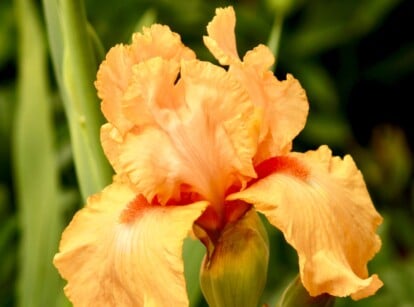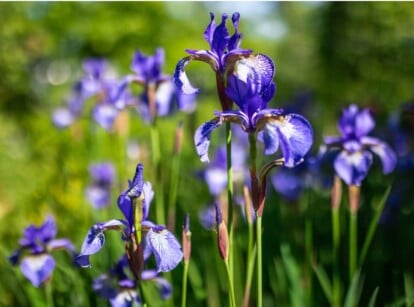How to Get Rid of Iris Borers in 7 Steps
Iris borers are the larvae of a brown moth. They look like mini caterpillars that tunnel into iris leaves and rhizomes. The damage they cause is significant, which is why control is crucial. Get rid of pesky iris borers with these seven easy steps from seasoned grower Jerad Bryant.

Contents
Iris borers are the most significant pests of irises. They can decimate your stands in a year, turning gorgeous gardens into weak, decrepit ones. Their life cycle starts when the brown moth, known scientifically as Macronoctua onusta, lays eggs on the leaves. The eggs hatch tiny caterpillars that begin boring into the irises.
After tunneling deep into the rhizomatous roots, the caterpillars eat the fleshy insides and leave frass, or insect poop, behind. The frass invites molds, bacteria, and other diseases that further harm your irises. This is why borer control and prevention is important—keeping them away prevents other pests and diseases from occurring.
To rid your crops of iris borers, you’ll want to inspect your plants beginning in early spring. Their eggs hatch as the weather warms and days lengthen, when the leaves reach four to six inches tall. Catch them early, and you’ll prevent them from damaging nearby specimens.
Step 1: Identify Iris Borers

Before seeing borers or moths, you’ll notice the signs of their arrival. The brown adult moths fly at night, which is why they’re difficult to identify. It’s easier to spot the damage their larvae cause. You’ll notice brown leaf edges, tunneling holes, and weak and yellow plants. Some foliage will have water-soaked markings that are soft to the touch.
The caterpillars leave brown, rotting holes where they bore into stems and leaves. Depending on the season, the worms may still be in the foliage, or they’ve reached the rhizomes beneath the soil. Catching them early on will help mitigate some of the damage they cause.
In other cases, the damage may be difficult to see until it’s too late. Strong, healthy irises may not exhibit yellow, brown, or weak leaves for some time after infestations occur. It helps to look closely at the plants; get low to the ground and inspect the lower portions of their foliage.
Step 2: Squish Tunneling Larvae

The caterpillars need some time to tunnel from the upper leaves into the lower rhizomes. If you catch them early, you can squish them between the fan-like leaves while they’re boring. Feel for the round and squishy larvae and squeeze them until they pop.
This step isn’t for the faint of heart! When squeezing the larvae, consider your plants’ health. The more you squish, the healthier your plants will be.
Once the caterpillars reach the rhizomes, it’s too late to squish them. You’ll need to excavate the rhizomes for a close inspection before cleaning or discarding them. Wait until the flowers finish blooming, then proceed with the next step.
Step 3: Dig Up Rhizomes Post-Bloom

It’s best to wait for the flowers to fade before checking the rhizomes. The plants move energy and nutrients upwards when they’re flowering, and digging them out will stress them further. After blooming, you may dig them up and replant them with little impact on their health.
Dig up any iris you suspect is a target of the borers, as evidenced by yellow, brown, or weak leaves with holes in them. Remove nearby irises that may also have infestations, as these caterpillars sometimes spread to nearby specimens.
Clean them of dead or damaged foliage and rinse off excess soil stuck to their roots. When clean, place all the dug-out irises in a bin, container, or pot for further inspection.
Step 4: Inspect Infected Plants

Iris borers have one generation per year, meaning they only reproduce once during the growing season. If borers are present in your plants, they’re from hatched eggs of the current spring. Removing these caterpillars from the roots prevents them from overwintering, pupating, and emerging as adult moths the next year. You’ll stop any eggs from appearing.
Inspect your irises by looking at their large, bulbous root systems. Press on them to see if they’re mushy, sunken, or rotting. Look for tunnels and holes with insect frass around the entrances. You may notice a caterpillar during your search! They’re white when young and reddish-pink when mature, with a dark brown head.
Separate the irises into two piles: infested and non-infested. Non-infested specimens are ready for planting; transplant, water, and cultivate them so they can once again establish themselves in your garden. Keep the infested rhizomes for cleaning or discarding.
Step 5: Clean or Discard Infested Rhizomes

Some irises are salvageable if the damage isn’t too severe. You’ll want to remove the caterpillars, clean the roots, and replant the damaged plants after cleaning. Start by locating the entrance wounds where the worms crawled into the rhizome. Begin cutting off wounded or rotted portions until you reach the worm.
Pull the worm out and discard it in soapy water. You may have to remove many leaves or rhizomatous portions to reach the worm. Clean the salvageable, worm-free roots so they’re free of frass and debris. The frass on the wounds may cause infections later after planting, so it’s a good idea to clean it off.
If the plant has severe damage and lacks shoots, it’s best to throw it away rather than clean it. You won’t have to get down and dirty finding the caterpillars! You may throw infested plants in your green waste bin, though you want to avoid putting them in your compost or around the garden.
If you kill the worms first, you may throw the infested plants into your garden. Simply put the rhizomes in a plastic trash bag, seal it, and leave it in direct sunlight in the yard for a few weeks. The sunlight will heat the inside of the bag and kill any remaining borers.
Step 6: Remove Debris in Fall

After eating the insides of the roots, the borers move into the surrounding soil to pupate. They emerge as adult moths in late summer and early fall to lay eggs on iris debris. Those eggs remain near the irises until spring, when they’ll hatch into baby caterpillars.
The best time for cleanup is immediately after the first hard frost in fall; the freezing temperatures kill adult moths, preventing them from laying more eggs. Wait until temperatures reach 28°F (-2°C) for four or more hours before removing any old debris.
Removing dead leaves, stems, and nearby weeds in autumn lowers the chances of eggs hatching next spring. It’s a good idea to clean up your iris garden in the fall to remove as many eggs as possible. Hot compost the dead leaves to kill the eggs with heat, or throw them away in a green waste bin.
Step 7: Apply Organic Pesticides in Spring

Steps one through six above will greatly reduce the chances of future borer infestations. If they’re persistent, some organic pesticides specific to these insects can help manage the larvae in spring. Spinosad is one organic option that works, though it also harms bees and other pollinators when wet.
It’s up to you whether or not to spray, as we all have different gardening styles. Apply the sprays in early spring when the iris leaves grow between four and six inches tall. Do so in the morning or afternoon to avoid harming active pollinators or beneficial insects.
Always follow the instructions on the pesticide’s label for proper dosage rates and application methods. The label is the law, and it’s illegal to apply a pesticide or herbicide in a manner inconsistent with its labeling. Protect yourself, your pets, and your family from pesticides, and wear protective gear during the application process.











